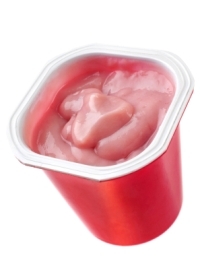How is yogurt made?
By Catalogs Editorial Staff

How is your favorite snack made?
When I first started to explore the topic of how yogurt is made, I was a little nervous. After all, yogurt is one of my favorite foods. Did I really want to know the nitty-gritty about the live cultures I was eating? Fortunately, discovering how yogurt is made was interesting and didn’t gross me out so much that I can’t enjoy a bowl of raspberry vanilla with fruit on the bottom. Read on to learn the facts and answer the question “How is yogurt made?”
Yogurt Ingredients
Yogurt is made when particular bacteria are added to milk in a precise, controlled environment and allowed to ferment (the process of turning carbohydrates to alcohol or acids). Most of the yogurt in the United States is made from cow’s milk. But milk from camels, goats and sheep is used to make yogurt in other parts of the world. Yogurt can also be made from soy milk.
For a substance to be called yogurt, it must contain two kinds of bacteria: Streptococcus thermophilus and Lactobacillus bulgaricus, although other types such as Lactobacillus casei are often used as well. Most yogurts contain live bacteria and remain unpasteurized. Pasteurized yogurt is also available. This type of yogurt has a long shelf life and doesn’t need to be kept refrigerated, but it doesn’t have the health benefits that live yogurt does.
Procedure
Milk is heated to a temperature of 200-degrees Fahrenheit (93-degrees Celsius) and kept at that temperature for 10 to 30 minutes, depending on the thickness that is wanted. Heating milk longer makes thicker yogurt. Then, the milk is cooled quickly to a temperature of 112-degrees Fahrenheit (44-degrees Celsius) and mixed with a “yogurt starter,” a concoction that contains the necessary bacteria.
The mixture is then placed in containers and allowed to incubate for a minimum of four hours at 100-degrees Fahrenheit (37-degrees Celsius). The longer the mixture is allowed to incubate, the more tart the yogurt will taste as more acids develop. Placing the yogurt in a cold environment such as a refridgerator stops the incubation process.
In flavored yogurts, flavors such as fruit, honey or maple are added after incubation.
Several important things must be taken into consideration to make yogurt.
-
A good sterile technique?the milk must be properly sterilized and cooled, and the glassware needs to be properly cleaned and sanitized to keep out unwanted bacteria
-
The proper temperature?Lactobacilli andStreptococcus thermophilus are thermophilic bacteria, which means they prefer higher temperatures for growth. However, even thermophilic bacteria will die if the temperature is over 55-degrees Celsius. In addition, they do not grow well at temperatures under 37-degrees Celsius
-
Protection of the starter from contamination
Why the Bacteria?
The bacteria eat the natural milk sugars and excrete lactic acid, which in turn causes the milk to curdle and create a more solid substance. The increased acidity of the dairy is too high for most harmful bacteria, so the yogurt keeps itself clean. Additional bacteria can be added for flavor or health benefits.
Benefits
The health benefits of eating yogurt are numerous. Rich in protein and vitamins, this dairy product can be eaten by those with lactose intolerance conditions because yogurt contains an enzyme that breaks down the lactose in the intestines. Yogurt containing Lactobacillus acidophilus is often eaten by women who suffer from yeast infections, because it creates an environment that is too hostile for Candida albican to survive.
Although it may seem odd that when you eat yogurt you are consuming live bacteria, the truth is that yogurt is both healthy and delicious and a good source of many essential vitamins such as calcium.
So, don’t be afraid to tell the nitty-gritty the next time someone asks, “How is yogurt made?” It’s not so frightening after all.
Popular Savings Offers




.png)
.png)


.jpg)
.jpg)
.png)
